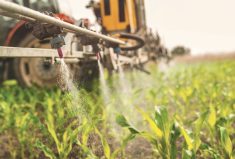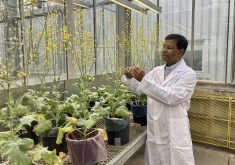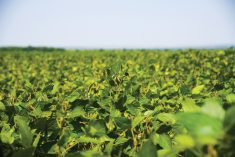You know the old saying: In order to make money, you’ve got to spend money.
But spend it wisely, says an Alberta Agriculture research scientist.
“There’s a lot of different agronomic practices out there that you can spend money on — but which ones are going to make you money?” Sheri Strydhorst asked attendees at the recent Feed Coalition workshop.
As part of a multi-year, multi-site research project, Strydhorst is looking at “advanced agronomic practices,” evaluating how nitrogen, fungicide, and plant growth regulators interact to help — or hinder — yield in wheat and barley.
Read Also

New crop insurer policy enables easier startup for faba beans
Agriculture Financial Services Corporation updated its normals for faba beans, which may open the door for more Canadian producers to feel comfortable growing the pulse crop in the future.
“Farmers don’t just use one thing in their fields; they farm as a system,” she said.
But only one input she studied offered a solid return on investment.
“Foliar fungicide is where we’re really getting the best returns on our input dollars,” said Strydhorst. “These advanced agronomic inputs were not good bang for your buck.”
On wheat, in high-moisture environments, nitrogen resulted in “small yield increases” — even actually decreasing yields at one dry site.
“If you’re just adding more nitrogen to a system that doesn’t have sufficient rain to take advantage of that nitrogen, you’re not going to see a response.”
It was the same story with plant growth regulators on wheat.
“The plant growth regulators under dry conditions actually caused a yield decrease,” she said, adding that under wet conditions they “didn’t do a thing for yield.
“Plant growth regulators are really finicky things. If you’ve got stressful conditions, do not use them.”
But at the high-moisture sites, applying fungicides resulted in a substantial yield bump.
“The single and dual fungicide applications increased yields between 28 and 48 per cent, and that’s where we saw the positive economic benefits,” said Strydhorst.
“From a risk perspective, using that single late fungicide application is where you’re getting the biggest bang for your buck.”
Yield increases were smaller at the drier sites — between six and 15 per cent — because the conditions weren’t conducive to disease development, she said.
“If you have a variety that has genetic resistance and also dry conditions, you’re not going to see a yield response to the fungicides,” said Strydhorst.
“On the other hand, if you have a cultivar that’s susceptible to everything under the sun, as well as warm, moist conditions, you’re going to get really high response to your fungicides.”
Dual fungicide application yielded better than a single one, but the gain didn’t outweigh the cost, she said.
“We might have had more yield with our dual fungicide application, but our return is the same,” said Strydhorst. “There’s a lot less risk of going with just the single fungicide application.
“It seemed that what was making us the most yield and the best economic return was the late fungicide application in our environments where we had more moist conditions.”
Barley study
The trends were “slightly different” in the barley crops, said Strydhorst.
“We lost money with most advanced agronomic practices,” she said. “Most things actually resulted in a net economic loss.”
Added nitrogen gave a “small boost” to the yield, she said. “It’s not always making us money though.”
With plant growth regulators on barley, Strydhorst saw increased yields — “which was surprising” — but no improved standability, the intended benefit of plant growth regulators.
“The plant growth regulators didn’t work any better in terms of standability at all,” she said, adding that barley is “less responsive” to plant growth regulators than wheat.
“We got that small yield boost, but we didn’t get a standability response. At this point, it’s not a good investment on barley.”
Fungicide effectiveness was “a lot smaller” on the barley than on the wheat.
“That can be attributed to the fact that the variety we were using has good genetic resistance,” said Strydhorst.
Based on these results, Strydhorst encourages producers to get back to basics before tackling advanced agronomic practices.
“We want to get the basics right. If you have, say, a plant population that’s half of what it’s supposed to be, you’re never going to hit those rock-star yields.”















